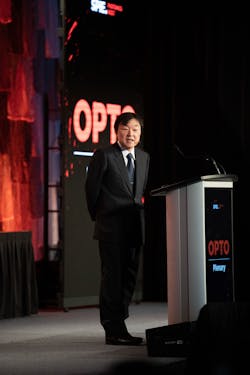In response to the ongoing COVID-19 virus pandemic, SPIE, the international society for optics and photonics (Bellingham, WA), will use its digital forum platform to organize its first five meetings of 2021. The organization’s optics and photonics technology event Photonics West will be held as an interactive, virtual conference March 6-11, 2021. SPIE Photonics West 2021 combines the three usual conferences (BiOS, LASE, and OPTO), plus this year’s event also includes Quantum West, an industry-focused conference on quantum technology.
“We’re in the process of putting together this year’s Photonics West Digital Forum program, and it already promises to be an exciting week,” notes SPIE Senior Director of Technical Programs and Proceedings Marilyn Gorsuch. “Even during these challenging times, SPIE continues to serve the photonics community, facilitating meetings, connecting colleagues, and helping to disseminate critical research. This year, SPIE Photonics West will continue to be a key nexus for peer communication and information-sharing, and we look forward to welcoming our community to our new Photonics West Digital Forum in March.”
Highlights
- Terrific roster of plenary speakers across LASE, OPTO, and BiOS Hot Topics.
- Networking opportunities with other Photonics West participants.
- Conference presentations and papers will be available on demand during the week of the show and the week after that, and will be accessible on the SPIE Digital Library.
- Great opportunities to connect with hundreds of the world’s top photonics exhibitors via the Photonics West and BiOS Digital Marketplaces. Registration is free to the Digital Marketplaces and to all other industry-related activities.
- Inaugural, industry-focused SPIE Quantum West event; registration is free to this event.
Registration and pricing details are available on the SPIE website at http://bit.ly/PWest-21.
LASE Symposium
The LASE plenary speakers will include pioneers in the field of electrical engineering and lasers, Gérard Mourou and Susumu Noda, Professor of Electronic Science and Engineering, Kyoto University (see Figs. 1 and 2). Mourou will discuss passion for the extreme-light laser, a universal source providing a vast range of high-energy radiations and particles along with the highest field, highest pressure, temperature, and acceleration. The extreme-light laser offers the possibility to shed light on some of the remaining unanswered questions in fundamental physics, like the genesis of cosmic rays with energies in excess of 1020 eV or the loss of information in black holes.Using wakefield acceleration, some of these fundamental questions could be studied in the laboratory. In addition, extreme light makes possible the study of the structure of vacuum and particle production in “empty” space, which is one of the field’s ultimate goals, reaching into the fundamental quantum electrodynamic (QED) and possibly quantum-cascade detection (QCD) regimes. Looking beyond today’s intensity horizon, Mourou will introduce a new concept that could make possible the generation of an attosecond-zeptosecond high-energy coherent pulse, de facto in x-ray domain, opening at the Schwinger level, the zettawatt, and peta electron volt (PeV) regime—the next chapter of laser-matter interaction.
Noda will first take a look at the progress of photonic crystal surface-emitting lasers (PCSELs), a unique type of semiconductor laser that can achieve single longitudinal- and lateral-mode oscillation even over areas of millimeters in diameter. Their brightness, defined as power per unit area per unit solid angle, is expected to be increased up to the range of 1~10 GW cm-2 sr-1, which is comparable to those of gas lasers and fiber lasers.
Then, Noda will cover the additional functions of PCSELs, including the generation of beams with various patterns and polarizations, and the ability to achieve electric two-dimensional beam scanning. Next, he will discuss material systems for PCSELs that are currently being expanded to not only InGaAs/GaAs (900–1000 nm), but also InGaAsP/InP (1.3–1.55 µm) and even InGaN/GaN (400–530 nm). Finally, Noda will discuss one example application where PCSELs will become a key light source in the forthcoming ultra-smart Society 5.0, which includes smart mobility and smart processing.
Also speaking during the LASE plenary session will be SPIE 2020 Gold Medal recipient Ursula Keller, Professor of Physics at ETH Zurich, on the topic of dual-comb modelocking with spectroscopy and lidar applications.
LASE, the industrial laser, laser source, and laser application conference, will highlight such topics as laser manufacturing; laser materials processing; micro-nano packaging; fiber, diode, and solid-state lasers; laser resonators; ultrafast lasers; semiconductor lasers and LEDs; and 3D fabrication technologies. The LASE conference program is concentrated into four tracks: Laser Sources, Nonlinear Optics and Beam Guiding, Micro/Nano Applications, and Macro Applications.
Laser Sources, the bedrock conference track of LASE, is divided into five topics: Solid State Lasers XXX: Technology and Devices; Fiber Lasers XVIII: Technology and Systems; High Power Lasers for Fusion Research VI; Components and Packaging for Laser Systems VII; and High-Power Diode Laser Technology XIX. Solid State Lasers, a vast topic in itself, includes subtopics such as eye-safe and mid-IR lasers, UV-VIS lasers, pulsed and ultrafast lasers, and novel laser concepts.
Novel Laser Concepts should catch the interest of many in Laser Focus World’s audience. It includes talks on intracavity spatial mode conversion by means of holographic phase masks (paper 11664-27); nonplanar ring oscillators: increasing tunability, reducing frequency noise; and optimizing manufacturability for the LISA gravitational wave detector (paper 11664-28); 1.064 µm CW stable single-frequency emission and noise reduction based on a monolithic cavity (paper 11664-29); and optical parametric amplification by two-dimensional semiconductors (paper 11664-30).
Those of you wondering when you will be able to buy a self-driving car may want to check out the eye-safe wavelength devices for lidar and sensing session (paper 11664-1), which delves into laser illuminators for long-reach lidar and gated imaging in harsh weather conditions for autonomous vehicles and automated shipping applications.
OPTO Symposium
OPTO, the optoelectronics, photonic materials, and device conference, is set to cover topics including silicon photonics, photonic crystals, optoelectronics, semiconductor lasers, and nanophotonics, plus quantum technologies for information, sensing, materials, and dots.
The two speakers at the OPTO plenary session cover topics that tie optics and photonic research to practical applications, both present and future.
Caltech’s Kerry J. Vahala discusses how combs provide a coherent link between electronics and photonics. First summarizing how their implementation has been transformative for time keeping, frequency metrology, precision spectroscopy, microwave-generation, ranging, and other technologies, and how more recently still, high-Q nonlinear optical microresonators, have enabled chip-scale frequency combs. Then, he will review efforts to fully integrate comb systems around these new ‘microcombs,’ along with the physical principles of the devices themselves. Finally, he will consider the revolutionary impact this chip-scale unification of the optoelectronic spectrum can have on photonic instrumentation and consumer products.
Next, Kohji Mitani of NHK Japan Broadcasting Corp. will discuss the evolution of two-dimensional media and advanced immersive sensory media, and the role recent R&D in 8K ultra-high definition television plays in immersive and realistic experiences on two-dimensional screens, including head-mounted displays, augmented reality glasses, three-dimensional displays, and haptic devices.
Topics of the many OPTO conference program tracks include: Optoelectronic Materials and Devices, Photonic Integration, Nanotechnologies in Photonics, MOEMS-MEMS in Photonics, Advanced Quantum and Optoelectronic Applications, Semiconductor Lasers, LEDS, and Applications, Displays and Holography, and Optical Communications: Devices to Systems.
For example, the Optical Materials and Devices conference covers Physics and Simulation of Optoelectronic Devices XXIX (conference 11680); Physics, Simulation, and Photonic Engineering of Photovoltaic Devices X (conference 11681); Optical Components and Materials XVIII (conference 11682); Organic Photonic Materials and Devices XXIII (conference 11683); Ultrafast Phenomena and Nanophotonics XXV (conference 11684); Terahertz, RF, Millimeter, and Submillimeter-Wave Technology and Applications XIV (conference 11685); Gallium Nitride Materials and Devices XVI (conference 11686); Oxide-based Materials and Devices XII (conference 11687); and 2D Photonic Materials and Devices IV (conference 11688).
For those with a focus on optics, the “Optical Components and Materials XVIII” conference has sessions on Modulators, Detectors, and Filters; Fibers and Waveguides; Lasers; Photoluminescence Materials, Nanoparticles, Plasmonic and Subwavelength Optical Components, and Sensing. The “Plasmonic and Subwavelength Optical Components” track, for example, includes sessions on nonlinear and hyperbolic metasurfaces and applications (paper 11682-34); electrically tunable metasurfaces by a single electro-optic layer (paper 11682-35); evolution of the optical properties in atomically thin plasmonic titanium nitride (paper 11682-36); arrayed graphene-enhanced surface plasmon resonance for sensing applications (paper 11682-37); optical super-resolving phase filters with random antireflection subwavelength surface structures (paper 11682-38); and bidirectional scattering distribution function of random antireflective nano-roughened surfaces (paper 11682-39).
BiOS Symposium
The Biomedical Optics Symposium (BiOS) covers topics such as biomedical optics, diagnostics and therapeutics, biophotonics, new imaging modalities, optical coherence tomography, neurophotonics, optogenetics, tissue optics, and nanophotonics. A perennial highlight of the annual event is BiOS Hot Topics, where one of the plenaries will be given by 2021 SPIE President-Elect Anita Mahadevan-Jansen (see Fig. 3).The BiOS conference program is concentrated into six tracks: Photonic Therapeutics and Diagnostics; Neurophotonics, Neurosurgery, and Optogenetics; Clinical Technologies and Systems; Tissue Optics, Laser-Tissue Interaction, and Tissue Engineering; Biomedical Spectroscopy, Microscopy, and Imaging; and Nano/Biophotonics.
The “Photonic Therapeutics and Diagnostics” conference covers topics such as Photonics in Dermatology and Plastic Surgery (conference 11618); Advanced Photonics in Urology (conference 11619); Imaging, Therapeutics, and Advanced Technology in Head and Neck Surgery and Otolaryngology (conference 11627A); Endoscopic Microscopy XVI (conference 11620); Diagnostic and Therapeutic Applications of Light in Cardiology (conference 11621); Multiscale Imaging and Spectroscopy II (conference 11622); Lasers in Dentistry XXVII (conference 11627B); Ophthalmic Technologies XXXI (conference 11623); Visualizing and Quantifying Drug Distribution in Tissue V (conference 11624); Optical Methods for Tumor Treatment and Detection: Mechanisms and Techniques in Photodynamic Therapy XXX (conference 11628A); Mechanisms of Photobiomodulation Therapy XVI (conference 11628B); Molecular-Guided Surgery: Molecules, Devices, and Applications VII (conference 11625); and Photonic Diagnosis, Monitoring, Prevention, and Treatment of Infections and Inflammatory Diseases 2021 (conference 11626).
Those interested in test and measurement may want to check out the “Multiscale Imaging and Spectroscopy II” session, which includes sessions on data-driven SFDI to measure molecular signals from widefield images (paper 11622-1); seeing the trees through the forest: training generalizable denoising neural networks using simulated data (paper 11622-2); optical-sectioning super-resolution structured illumination microscopy for fast virtual pathology (paper 11622-3); a novel method for generating structured illumination of structured illumination microscopy using phase modulation (paper 11622-4); and snapshot gigapixel-scale imaging at high resolution using a micro-camera array microscope (paper 11622-5).
Of course, there is so much more, but just like the event itself, space and time keep me from reporting everything. No matter how you experience BiOS 2021, however, it is sure to supply you with plenty of inspiration. Enjoy!
About the Author
John Lewis
Editor in Chief (2018-2021)
John Lewis served as Editor in Chief of Laser Focus World from August 2018 through October 2021, after having served as the Editor in Chief of Vision Systems Design from 2016 to 2018. He has technical, industry, and journalistic qualifications, with more than 13 years of progressive content development experience working at Cognex Corporation. Prior to Cognex where his articles on machine vision were published in dozens of trade journals, he was a technical editor for Design News, covering automation, machine vision, and other engineering topics, for over six years.



